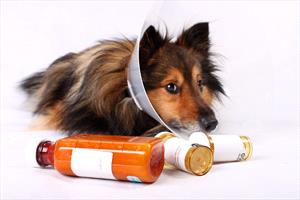
Impalement and penetrating injuries involve a foreign body stuck in an animal, usually in a body cavity like the abdomen or chest, or deep wounds where the skin is broken. Common examples in small animals include pets shot with arrows or crossbow bolts, dog fight injuries, and gunshots. Dogs frequently carry sticks in their mouths and suffer mouth or neck injuries when the end of the stick jams into the ground. Pets can also fall from multi-story buildings and become impaled on fences or other sharp objects. A veterinarian should be seen as soon as possible. Impalement injuries can lead to serious internal damage.
Sedation, pain control, and/or general anesthesia are almost always needed to determine where the impalement occurred and how much internal or hidden damage has occurred. Some foreign bodies, such as wood, do not show up on routine X-rays, so more advanced tests (such as ultrasound or MRI) may need to be used.
Sheltie_woundmeds

Sometimes testing, treatments, and/or medications are needed to help your pet recover from an impalement or penetrating wound.
Occasionally, parts of the foreign body will become lodged in the pet’s skin or tissues, even after most of it has been removed. These can migrate to different parts of the body and cause problems weeks later.
Some injuries inflicted by other dogs can appear minor at first, but may have severe damage to deeper tissue; we call these ‘tip of the iceberg’ injuries. Dog fight injuries can sometimes become worse before they become better due to the crushing forces involved in the bite injury and death of the overlying skin (necrosis). Sometimes a pocket of infection (abscess) may form that requires the placement of a tube to drain accumulated fluid.
What to Do
- Calm and blanket the pet.
- Muzzle the pet so you avoid getting bitten.
- Attempt to immobilize both the foreign body (if it’s still there) and the pet. Severe and continuing damage is done whenever the foreign body is allowed to flail about the inside of the pet.
- If the foreign body is in the chest, or there is damage to the chest, listen for sounds of air sucking or whistling around the wounds. If it appears that there is an open wound in the chest, cover the wound (and the foreign body, if necessary) with plastic wrap. Before you place the plastic wrap, apply petroleum jelly, sterile lubricant, or antibiotic ointment to help seal the wound.
- If the foreign body can easily be cut, shorten it, leaving only 3 to 6 inches sticking out of the pet.
What NOT to Do
- Never try to remove the foreign body yourself.
- Do not allow the pet to move.
- Do not move the foreign body while cutting it.
- Do not avoid seeking veterinary attention, just because a wound seems minor – there can be extensive hidden damage that needs medical attention.
Browse the complete Veterinary Partner First Aid collection.